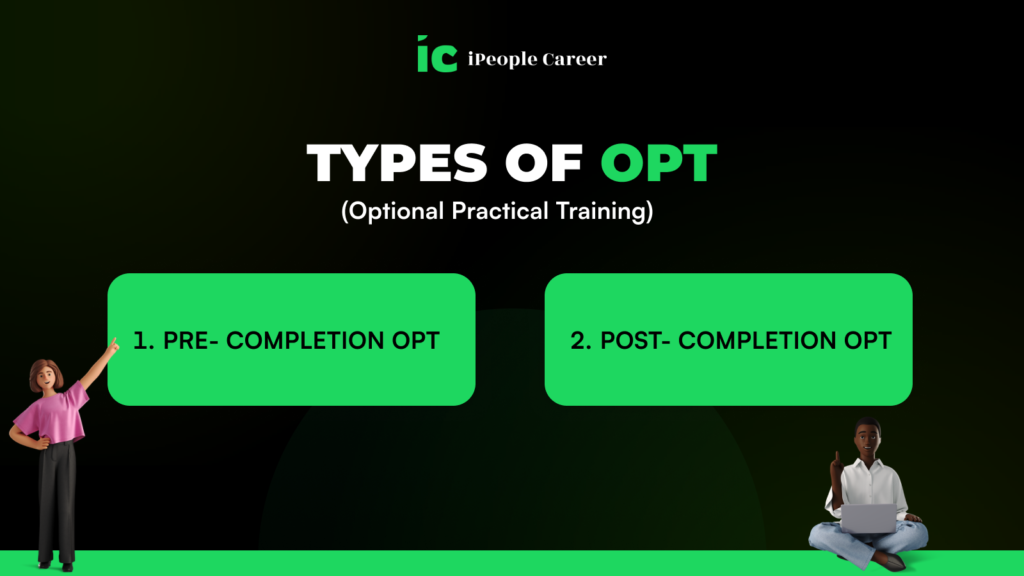
Just imagine: you’d be able to apply everything you learn in class right there in the United States. Imagine how great it would feel if, instead of just passing, getting your degree could mean your dream job would finally be within reach. Doesn’t that sound interesting?
Optional Practical Training (OPT) makes this a reality for foreign students on F-1 visas. Just imagine living in the United States after graduation, working for a reputable company, gaining practical experience, and making your resume stand out internationally. Wouldn’t that be a great thing?
Keep reading to find out how you can benefit from this opportunity. This blog covers everything you need to know about OPT, including what it is, why it matters, and how to make the most of it.
What is Optional Practical Training (OPT)?

OPT is a chance for F-1 students to work in the US for a short time, 12 months at most, but it has to be related to what they are studying.Work experience can benefit the students’ careers by being able to apply what they learned in school in an actual job.
If the students study in other specific STEM fields such as science, technology, engineering, or mathematics, they might also work under OPT for an additional 24 months, respectively. It also means that students could stay and work in the U.S. for three years.
Key facts about OPT:
-
- OPT students must have studied for at least a year in the U.S. before OPT.
- You can stay in the country for up to 12 months with standard OPT. If you study in science, technology, engineering, and math (STEM) fields, you can also extend your OPT for an extra 24 months.
Why is OPT Important for International Students?
As an international student, working in the U.S. can help your career in many ways:
-
- Professional Development: Use what you learned in school to solve real-life problems.
- Networking: Know and connect people in your job area.
- Career Opportunities: Many companies use OPT to help students get an H-1B work visa later.
- Competitive Edge: Work experience in the U.S. makes your resume better and helps you get jobs around the world.
Type of OPT

1. Pre-Completion OPT
Pre-completion OPT lets you work before you complete your graduation. This type is less common because many students prefer to work after graduating. But it’s a good choice if you want to get work experience while still in school.
Key Points:
-
- You can work part-time (up to 20 hours a week) while classes are in session.
- You can work full-time during school holidays or breaks.
- Any time you use for pre-completion OPT will be taken away from your total 12-month OPT limit.
2. Post-Completion OPT
Post-completion OPT is the most popular option. It lets you work after you’ve finished your degree. Most students use this time to get full-time work experience.
Key Points:
-
- You must work full-time (40 hours a week).
- You can work for more than one employer or switch jobs, as long as the work is related to your field of study.
What is the STEM OPT Extension?

The STEM OPT Extension is an additional work permit given to F-1 students who have finished a degree in a STEM area (Science, Technology, Engineering, or Mathematics). This extension lets qualified students add 24 more months to their Optional Practical Training (OPT), giving them up to 36 months total to work in the United States.
This gives the student in the STEM program more time to acquire hands-on experience and skills, and also potentially to gain employment permanently in the United States with a work visa.
Eligibility for STEM OPT Extension
- You need to have a degree in a STEM field that is approved.
- Your employer must use the E-Verify system.
- The job you do must be directly connected to your STEM degree.
- This extension is very helpful for STEM students because it gives them more chances to find a permanent job or move to an H-1B work visa
Eligibility Requirements for OPT
Not all international students are eligible for OPT. Here is a simple checklist to see if you qualify:
- F-1 Visa Status: You must have complied with all requirements of your F-1 visa while studying.
- Academic Enrollment: You should have completed at least one full academic year of school in the U.S.
- Work Relevance: The job has to be in line with your major field of study.
- No earlier OPT use: If you’ve already used OPT for your present degree, then you cannot again apply for that particular degree.
How to Apply for OPT: A Step-by-Step Guide
 OPT application is not an easy procedure, but following these steps makes it easier.
OPT application is not an easy procedure, but following these steps makes it easier.
Step 1: Meeting Your DSO
First, talk to your school’s Designated School Officer (DSO). They will see if you can apply for OPT and update your Form I-20 to recommend OPT. You need this recommendation to apply for OPT.
Step 2: Complete Form I-765
After this, you should submit Form I-765, Application for Employment Authorization. You can submit this application online or by mail. With your application, attach all supporting documents, including:
-
- An updated Form I-20.
- A copy of your passport and visa.
- Two passport-sized photos.
Step 3: Submit Your Application to USCIS
When all the papers are ready, send your application to the US Citizenship and Immigration Services (USCIS). Make sure you send your application by these deadlines:
-
- 90 days before your graduation date.
- You have up to 60 days after graduation to apply.
Step 4: Wait for Your EAD Card
Once USCIS accepts your application, you will receive an Employment Authorization Document, which is referred to as the EAD. This card will indicate that you are allowed to work.
Step 5: Start Work
You can begin working only when you have the EAD card and the date on the card has passed.
Tips to Get the Best Out of Your OPT
-
- Start early: Research for job opportunities before your OPT is approved.
- Build your resume: Highlight relevant academic projects and skills.
- Use career services: Most universities help international students find employment.
- Network: Attend career fairs, get on LinkedIn, and connect with alumni in your field.
- Be compliant: Report your job to your DSO and keep track of your work permit deadlines.
Common Challenges and How to Solve Them
1. Delays in Process
OPT applications can take between 90 to 120 days to be processed.
To avoid delays:
-
- Apply as soon as you can.
- Double-check your application to make sure there are no mistakes.
2. Finding a Job
It can be hard to find a job within the 90 days you’re allowed to be unemployed under OPT.
To increase your chances:
-
- Look for internships or unpaid work in your field.
- Use platforms like LinkedIn, Indeed, and Handshake to search for jobs.
3. Changing Employers
If you switch your job during OPT, make sure the new job is related to your field of study. Notify your DSO (Designated School Official) about the change immediately.
Conclusion
OPT is an important program for international students in connecting their studies to real work experience. It allows you to gain important skills and can lead to job opportunities both in the United States and globally.
Know the rules, apply early, and keep looking for jobs to make the best use of OPT. If you can get OPT, don’t wait-start preparing now to benefit the most from this amazing opportunity offered by the country for your future job.




